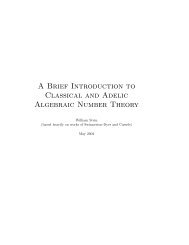COMPUTATIONAL VERIFICATION OF THE BIRCH ... - William Stein
COMPUTATIONAL VERIFICATION OF THE BIRCH ... - William Stein
COMPUTATIONAL VERIFICATION OF THE BIRCH ... - William Stein
Create successful ePaper yourself
Turn your PDF publications into a flip-book with our unique Google optimized e-Paper software.
16 GRIGOROV, JORZA, PATRIKIS, STEIN, AND TARNIT¸ Ǎ-PǍTRAS¸CU<br />
Thus one method to find iK is to find a generator z ′ ∈ E D (Q) exactly using descent<br />
algorithms, which will terminate since we know that X(E D ) is finite, by Kolyvagin’s<br />
theorem. However, since E D has potentially large conductor and rank 1, in<br />
practice the Mordell-Weil group will sometimes be generated by a point of large<br />
height, hence be extremely time consuming to find. One can use 2-descent, 3descent,<br />
4-descent, and Heegner points methods (i.e., explicitly compute the coordinates<br />
of the Heegner point as decimals and try to recognize them using continued<br />
fractions.) In some cases these methods produce in a reasonable amount of time<br />
an element of E D (Q) of infinite order, and one can then saturate the point using<br />
[Creb] to find a generator z ∈ E D (Q). However, we will explain a trick below to<br />
get information about the index without actually computing it.<br />
Example 3.22. Let E be the curve 11a, with Weierstrass equation y2 + y =<br />
x3 − x2 − 10x − 20. The first field that satisfies the Heegner hypothesis is K =<br />
Q( √ −7). The conductor of the quadratic twist F = E−7 is 539, and we find a<br />
generator z ∈ F (Q) for the Mordell-Weil group of this twist. This point has height<br />
hQ(z) ∼ 0.1111361471. We have |D| = 7 and Vol(C/Λ) ∼ 1.8515436234, so<br />
√<br />
7<br />
α ∼<br />
∼ 0.71447177.<br />
2 · 1.8515436234<br />
Also, L(E, 1) ∼ 0.25384186 and L ′ (E D , 1) ∼ 1.225566874, so the height over K of<br />
the Heegner point is thus<br />
Thus by (3.5)<br />
h(yK) ∼ 0.71447177 · 0.25384186 · 1.225566874 ∼ 0.2222722925.<br />
i 2 K = h(z) 2hQ(z)<br />
= ∼ 1.<br />
h(yK) h(yK)<br />
As mentioned above, there is a trick to bound the index iK without computing<br />
any elements of E(K). This is useful when the algorithms mentioned above for<br />
computing a generator of E D (Q) produce no information in a reasonable amount<br />
of time. First compute the height h(yK) using the Gross-Zagier formula. Next<br />
compute the Cremona-Prickett-Siksek [CPS06] bound B for E D , which is a number<br />
such that if P ∈ E D (Q), then the naive logarithmic height of P differs from the<br />
canonical height of P by at most B. Using standard sieving methods implemented<br />
in [Creb], we compute all points on E of naive logarithmic height up to some number<br />
h0. If we find any point of infinite order, we saturate, and hence compute E D (Q),<br />
then use the above methods. If we find no point of infinite order, we conclude that<br />
there is no point in E D (Q) of canonical height ≤ h0−B. If h0−B > 0, we obtain an<br />
upper bound on iK as follows. If z is a generator for E D (Q), then hQ(z) > h0 − B,<br />
so using (3.5) we have<br />
hQ(z) = 1<br />
2 · hK(z) = h(yK)<br />
2 · i2 Solving for iK gives<br />
> h0 − B.<br />
K<br />
<br />
(3.9) iK <<br />
h(yK)<br />
2(h0 − B) ,<br />
so to bound iK we consider many K (e.g., the first 30 ordered by absolute discriminant),<br />
and for each compute the quantity on the right side of (3.9) for a fixed choice<br />
of h0. We then use a K that minimizes this quantity.
















